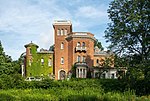Lafayette Memorial
1917 establishments in New York (state)1917 sculpturesBronze sculptures in BrooklynCultural depictions of Gilbert du Motier, Marquis de LafayetteHorses in art ... and 8 more
Monuments and memorials in BrooklynOutdoor sculptures in BrooklynProspect Park (Brooklyn)Reliefs in the United StatesSculptures by Daniel Chester FrenchSculptures of men in New York CityUse American English from February 2021Use mdy dates from February 2021

The Lafayette Memorial is a public memorial located in Brooklyn's Prospect Park in New York City. The memorial, designed by sculptor Daniel Chester French and architect Henry Bacon, was dedicated in 1917 and consists of a bas-relief of Gilbert du Motier, Marquis de Lafayette alongside a groom (speculated by some historians to be James Armistead Lafayette) and a horse.
Excerpt from the Wikipedia article Lafayette Memorial (License: CC BY-SA 3.0, Authors, Images).Lafayette Memorial
Prospect Park West Bike Path, New York Brooklyn
Geographical coordinates (GPS) Address Nearby Places Show on map
Geographical coordinates (GPS)
| Latitude | Longitude |
|---|---|
| N 40.664444444444 ° | E -73.976583333333 ° |
Address
Marquis De Lafayette Monument
Prospect Park West Bike Path
11215 New York, Brooklyn
New York, United States
Open on Google Maps










